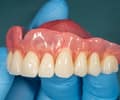What are denture implants? Permanent implant-supported dentures are a type of overdenture that is supported by and attached to dental implants in the jawbone that extend outward from the gums. What’s an overdenture? It’s a complete or partial denture that sits on top of or is attached to underlying tooth structures or dental implants. Like other dentures, overdentures are removable, but they can also provide improved function and retention when compared to conventional dentures, which may become unstable over time or require refitting.
Two Types of Implants
Whereas conventional dentures rest on the gum and may be attached to the natural teeth, implant-supported dentures are dentures held in place by implants. Implants connect to a surgically-fixed foundation attached to the jawbone. Once your dentist determines if you’re a good candidate for implants, including having sufficient jawbone, they will determine which of the two types of implants to use.
Bar-retained: a thin metal bar attaches to two to five implants in the jawbone. Clips or similar types of attachments fix the denture to this bar.
Ball-retained: Ball-retained dentures, also called stud-attachment dentures, usually contain sockets that fit onto ball-shaped connectors on the implants.
The Implant Process
According to the Mayo Clinic, the type of implant and the condition of the jawbone will determine how the dental implant surgery is performed. Dental implant surgery may involve several procedures occurring over many months. While it may sound intensive, the primary benefit of implant-supported dentures is the reliable support, as opposed to the slippage or bone damage that a fixed bridgework or dentures can bring.
Implants are usually placed in the jawbone at the front of your mouth, and the time frame can last from five months to a year or more depending on the need for bone grafting or other preliminary procedures. Generally, it’s a two-surgery process with the first surgery places the implants in the jawbone under the gums and the second surgery exposes the tops of the implants. However, a one-stage procedure is now available where they place the implants and supporting bars in one step. Your dentist can determine the best course of action.
Initial consultation
A prosthodontist or a general dentist who has advanced training in the placement and restoration of dental implants will perform an initial exam to:
- Review your medical and dental histories.
- Take X-rays and create impressions of your teeth and gums so that models can be made.
- Order a CT scan to identify sinus and nerve placements as well as determine how much bone is available.
In addition to these initial steps, they will create a temporary denture (if you don’t already have a full denture) to use until they place the implant-supported denture. The temporary denture has a dual function, both to determine the best position for the teeth in the final denture, and as a guide to help place the implants. Plus, it can be used as a backup if something happens to your final implant-supported denture. Keep in mind, creating the temporary denture can take up to a month, so include that in your timeline.
First surgery: Placing implants in the jawbone
Step 1: The patient is anesthetized in the area where the dental implants will be placed.
Step 2: An incision is made in the gum where the implant will be placed.
Step 3: A hole is drilled in the bone.
Step 4: The implant is placed into the hole, and the surgical area is stitched closed.
It’s essential to avoid pressure on the implants as you heal. The temporary dentures used before the surgery will direct pressure to other areas of the gums. Depending on if the implants are in the upper or lower jaw, you will have to wait three to six months as the bone and implants attach and fuse.
Second surgery: Exposing implant heads
Step 1: An X-ray determines if the implant has fused with the bone.
Step 2: The patient is anesthetized in the area of the dental implant area.
Step 3: A small incision is made in your gum to expose the tops (heads) of the implants.
Step 4: A healing cap (collar) is placed on the head of each implant after it’s exposed, guiding the gum tissue to heal correctly.
The collar(s) will be in place for ten to fourteen days before being replaced with regular abutments. Your dentist will make an impression of your gum tissue and abutments to make the denture framework and teeth.
Denture Try-In and Insertion
You’re almost there! At this point, the metal bar is placed on the abutments and your dentist will see if your denture framework fits correctly.
Step 1: The denture teeth are temporarily placed on the framework in wax before the whole denture is made and placed and secured onto the bar or ball attachments.
Step 2: The bar or ball attachments are secured.
Step 3: The denture is clipped onto the bar or snapped onto the ball attachments.
Post-Care
As a reminder, your denture is stable but can still move slightly when chewing, causing sore spots on gums. Your dentist will check your gums and bite after insertion of the denture. Be aware; a bar-retained denture carries certain risks of its own including:
Loose teeth: You could be at risk for teeth coming loose from the base because there’s less space available on the denture framework.
Passive fits: If the bar is not balanced evenly on each implant there is extra strain, causing screws to loosen.
Denture breakage: This is due to grinding or clenching your teeth.
Replacement: The clip or other attachments will need to be replaced every six to twelve months.
How to care for your implant-supported dentures
According to the American Dental Association (ADA), caring for your dentures is similar to caring for natural teeth. You should brush twice daily to remove food particles and plaque and to prevent staining. You should also:
- Rinse your dentures before brushing to remove any loose food or debris.
- Use a soft-bristle toothbrush and a non-abrasive cleanser to gently brush all the surfaces of the dentures so they don't get scratched.
- Carefully clean around the attachments.
- When brushing, clean your mouth thoroughly—including your gums, cheeks, roof of your mouth and tongue to remove any plaque. Brushing can help reduce the risk of oral irritation and bad breath.
- When you’re not wearing your dentures, put them in a safe place covered in water to keep them from warping.
Getting implant-supported dentures is an involved process with numerous benefits. Talk to your dentist to help determine if it’s the right choice for your oral health and smile.
This article is intended to promote understanding of and knowledge about general oral health topics. It is not intended to be a substitute for professional advice, diagnosis or treatment. Always seek the advice of your dentist or other qualified healthcare provider with any questions you may have regarding a medical condition or treatment.
ORAL HEALTH QUIZ
What's behind your smile?
Take our Oral Health assessment to get the most from your oral care routine
ORAL HEALTH QUIZ
What's behind your smile?
Take our Oral Health assessment to get the most from your oral care routine
Join Us
Get the best of your oral health routine and take it to the next level with expert advice, recommendations, products and solutions and special offers.
Join Us
Get the best of your oral health routine and take it to the next level with expert advice, recommendations, products and solutions and special offers.















